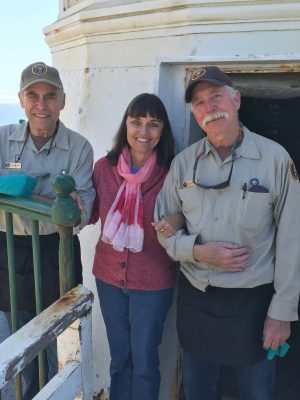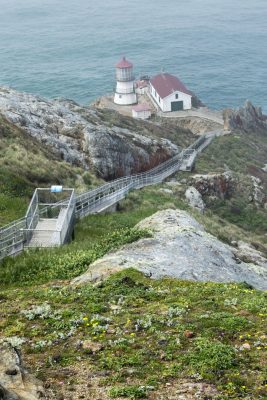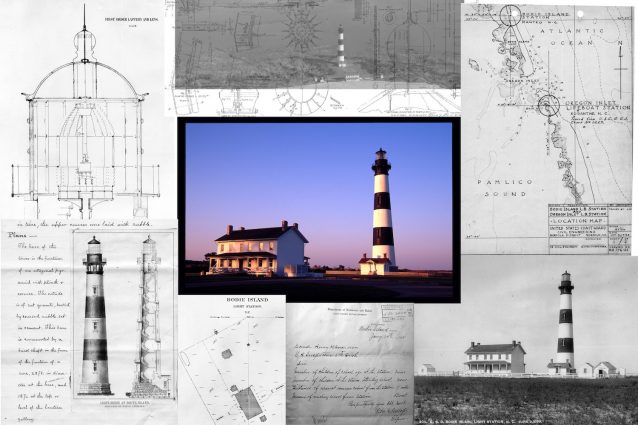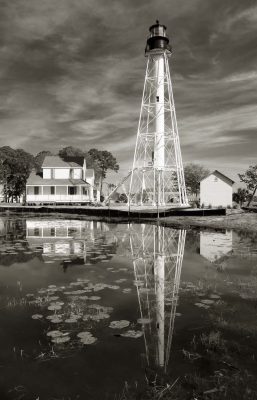Candace Clifford didn’t always love lighthouses.
“They weren’t on my radar,” the author, photographer and ‘lighthouse historian’ admitted. “It was only when I started working for the National Park Service (NPS), and they asked me to do an inventory of all the lighthouses in the country, that I became very aware of them.”
That was back in 1990, when Clifford joined a program called the National Maritime Initiative that aimed to inventory maritime resources: “Ships, shipwrecks, lighthouses, lifesaving stations—I was kind of in charge of the lighthouses,” she explained. “I gradually became, like, ‘the lighthouse expert.’”

This month, her lighthouse expertise is on full display in Glen Echo’s Park View Gallery, a second-floor spot in the Art Deco-style Arcade Building overlooking the historic Dentzel Carousel, with an exhibition of Clifford’s photographs (and accompanying drawings, maps and historical information) called “Enduring Beacons: Documenting America’s Lighthouses.”
The show brings together art, science and history—Clifford pointed out that studying lighthouses provides a perfect example of STEAM (Science, Technology, Engineering, Arts and Math) education. And while her historian credentials help her pick out lots of interesting details—George Washington himself authorized the construction of Long Island’s Montauk Lighthouse in 1795, for example, and Treasury Secretary Alexander Hamilton’s many accomplishments included founding the U.S. Revenue Cutter Service in 1790, which later combined with the Life-Saving Service to form the US Coast Guard—it’s her eye for fine art that makes this show special.
“I am a landscape photographer,” said Clifford who is a member of the Art League in Alexandria, where she shows her work.
So, while her primary purpose has been documentation, Clifford admitted that on many of her field excursions to historic lighthouses across the country, she has found the beauty of her subjects overwhelming. “Like Pemaquid,” she said, referring to one of the show’s most stunning images, a sunset shot of Maine’s Pemaquid Point Light Station. “I remember rushing to get there so I’d have time before the sun went down. That one did work; I was pleased with it.”

Some familiar lighthouses are represented here: Maryland’s Drum Point Lighthouse, a classic screw-pile structure that can now be seen on Solomon’s Island as part of the Calvert Marine Museum, and Alcatraz Island Light, with its illustrious reputation as the tallest structure on The Rock. There are coastal and lake lighthouses, historical documents, maps, diagrams and up-close views of foghorns and light lenses. Clifford’s photograph of the lens at San Francisco’s now-retired Point Reyes Lighthouse, Fog Signal and Lifesaving Station is a must-see.
“That was such a special tour, a real treat,” she remembered. “We got to go in the tower and see how the lenses were run by a clockwork mechanism, like a grandfather clock.” Clifford and her group watched the winding of the weights that turned the lighthouse lenses, large glass prisms that were constructed in France in 1867.
“I was surprised that it was still operational,” she said. “And that bright red color—it was just phenomenal.” While it technically works, the NPS-owned lighthouse—like so many in this era of GPS technology—is no longer used for navigational purposes.
There are 600 historic lighthouses in the country, Clifford said, most in very isolated locations. Has she seen them all? “No, I wish I had,” she said wistfully, noting that “only a handful of people” have seen each and every one. “Most of the records are here in D.C. at the Archives, so I spent a lot of time here doing research. I occasionally get to travel, but I have not seen all of them.”
The ones Clifford has seen make for some intriguing visual images. “There are so many aspects that interest people,” she said. “Some people love the architecture, some love the artifacts—the beautiful lenses—but me, I’m interested in the keepers: the people who kept them operational and the people who are preserving them now.”

Clifford said she created the “Enduring Beacons” exhibit to tell the story and honor the dedication of the communities that love their lighthouses and the volunteers who commit themselves to upkeep and preservation. Lighthouse aficionados can learn more from her blog on the U.S. Lighthouse Society’s website: uslhs.org.
“I really admire the efforts that go into preservation; I don’t think people realize how much work it is,” said Clifford, noting that a harsh marine environment can wreak havoc on these historical structures, and that restoration and public accessibility can be costly and time consuming.
She is a wealth of fun facts about lighthouses. When one needs to be moved, for example, it’s best to retain the services of a chimney moving company like International Chimney (“similar shapes,” she pointed out). Lighthouses painted with different paint patterns—a black-and-white checkerboard on Cape Lookout, a black-and-white spiral on Cape Hatteras, black-and-white bands on Bodie Island—are sporting “daymarks,” which offer daylight guidance similar to their nighttime lights. Not that lighthouses are relied upon by modern-day sea captains or even recreational boaters: technology has relegated most lighthouses to museum status, and they anchor communities, attract tourists and provide educational and recreational opportunities. While she loves every lighthouse she has seen, Clifford admits to a favorite: Boston Light, on Little Brewster Island in outer Boston Harbor.

“It’s on an island, and I love lighthouses that are on an island because you have to take a boat to get there,” said Clifford, who grew up traveling, but recalled that her family was often posted near the water, which she loved. “You can kind of feel what it’s like to be a keeper: you’re kind of away from everything, away from the world. You understand how challenging it would have been.”
The challenging life of the lighthouse keeper fascinates Clifford as much as the history and the structures themselves. She noted that the job often fell to entire families, and that many widows took over as keepers when their husbands passed away. Indeed, Clifford collaborated with her mother, author Mary Louise Clifford, on “Women Who Kept the Lights: An Illustrated History of Female Lighthouse Keepers,” and “Mind the Light, Katie: The History of Thirty-Three Female Lighthouse Keepers.”
“I love the human stories,” she said. “So, I’m always interested in reading keeper’s logs and any of the correspondence that’s survived. The things they complain about, the things they lack—there was some drama, shipwrecks and rescues, but most of their lives were pretty mundane. Just taking care of the light and fog signal was a 24/7 kind of activity.”
Carrying that light forward, for this artist and historian, seems to be a labor of love.
The Glen Echo Park Partnership presents “Enduring Beacons: Documenting America’s Lighthouses” by Candace Clifford through Aug. 26 at the Park View Gallery, Glen Echo Park, 7300 MacArthur Blvd., Glen Echo. The gallery is open Monday through Saturday, 10 a.m. to 6 p.m. Call 301-634-2222 or visit www.glenechopark.org.